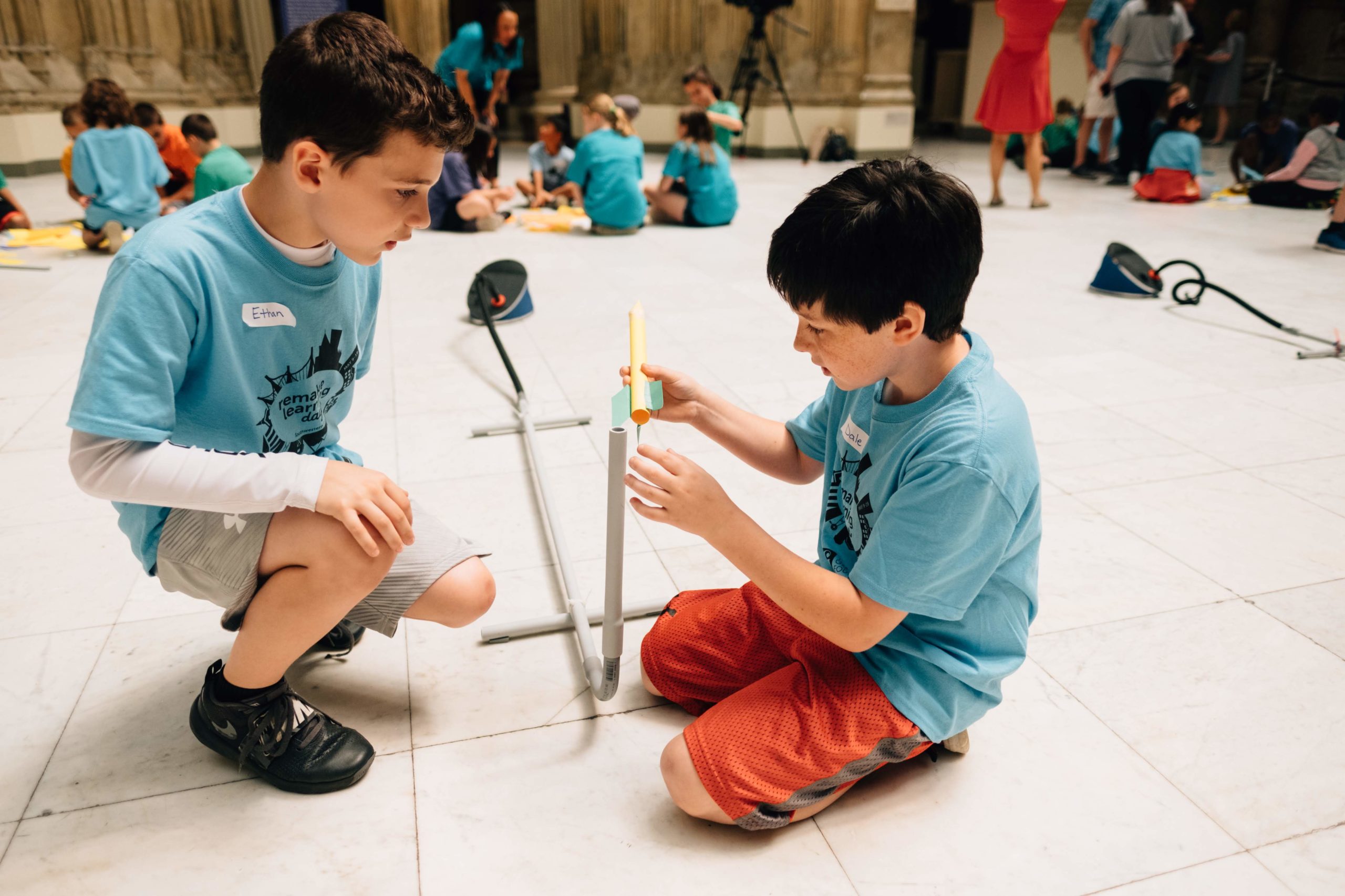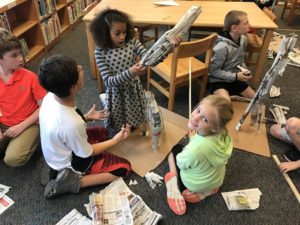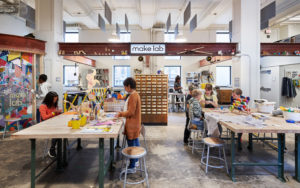
Kidsburgh Learning Guide: Making the most of maker learning
Parents hear a lot about the 21st-century skills that our children will need for their future. Today’s kids will someday pursue jobs that don’t even exist yet. And their daily lives may not resemble the ones we live today.
As the world keeps changing, we know they will need to be flexible thinkers who can collaborate with each other and feel comfortable solving problems. One of the best ways to teach these skills—and teach a bit of math and science, too—is to help children discover what it means to be a “maker.”
WHERE TO BEGIN
At Assemble, a community space in Pittsburgh where kids discover maker learning, director Nina Barbuto teaches “soft skills” like problem-solving and flexible thinking every day. She also needed these skills frequently during the pandemic, as the folks at Assemble and other after-school organizations responded to a crisis like nothing they’d seen before.
The pandemic “was just a total proof of concept,” she says, about the importance of having a maker mindset. “The future is so unknown that you’ve got to get ready to be a learner.”
Adults and children, she says, must be able to use whatever tools are around them in resourceful and creative ways.
Here’s the best part: Maker work doesn’t have to involve complicated tools (though it can, and we’ll tell you where to find those below). And it doesn’t necessarily require any special training (though you can get that in Pittsburgh, too, and the guide below will help you find it).
The experience of being a maker is accessible to everyone and it can happen right in your own home.
WHAT YOU CAN DO TODAY
What is maker learning? The folks at Remake Learning describe it this way: “Maker learning is about developing the curiosity to explore new ideas and the confidence to tackle difficult challenges, all while learning to use tools and materials to make (and re-make) the world around you.”
It can involve something as simple as snapping together LEGO bricks or as high-tech as using a 3D printer. The key is that you’re using your hands to create something. Many school districts, like Duquesne City, have created in-house makerspaces in their school buildings. But any room – including your kitchen – can become a makerspace for your child.
MAKING AT HOME
If you’re looking for ideas and materials, pay a visit to the Pittsburgh Center for Creative Reuse to find an incredible range of very inexpensive recycled items for any craft project you can imagine. From fabric remnants, beads and old license plates to used sports trophies, tiny figurines and even random forks and spoons, they have an ever-changing selection.
Looking to do even larger maker projects? Next to the Center for Creative Reuse, you’ll find Construction Junction. It’s the perfect place to find used furniture for large-scale maker and upcycling projects for the whole family.
If you’re seeking ideas, check out Assemble’s Crafternoon videos on Youtube, which offer easy-to-follow instructions for a slew of cool projects. Their virtual afterschool programming also provides materials and instructions for activities kids can do at home.
The Pittsburgh Cultural Trust also offers virtual making ideas for kids, including plush bunnies made from old t-shirts and a bookbinding project made from junk mail.
Another way to seek inspiration for at-home making: Visit the many local craft fairs and flea markets that offer handmade goods. Handmade Arcade and I Made It! Market are great places to start. The professional makers who sell their wares at these events tend to be enthusiastic about discussing the items they make and how they learned their skills.

PLACES FOR MAKING
The MAKESHOP at Pittsburgh’s Children’s Museum is stocked with the same tools and materials used by professional makers. With help from a team of educators, kids can try their hands at skills like sewing, woodworking, building with circuitry and stop-motion animation. Perhaps best of all, they can take apart (and possibly put back together!) small appliances and recycled toys to discover how they’re constructed.
Matt’s Maker Spaces can now be found in many elementary schools, libraries and other locations around the region (and they’ve recently expanded beyond Pennsylvania).
At Assemble, Pittsburgh kids will find programs touch on science, technology, engineering, math and the arts—all through the lens of hands-on making and learning. This summer, they’ll be hosting in-person and virtual summer camp.
Art spaces like Hatch Art Studio also offer making and tinkering, as does Contemporary Craft (check out the Drop-In Studio) and the Irma Freeman Center for the Imagination, where summer camp projects include planning and making rocket and spaceships out of cardboard, fabric, clay and more.
Another popular maker spot: Snapology, located in Bridgeville, which offers classes and camps where kids can build with LEGO, K’Nex and other technology. Snapology’s Discovery Center is open for drop-in creative play seven days a week.
Artist and arts educator Cheryl Capezzuti also recommends Cut and Sew in Morningside, where her own daughters discovered how much fun making with textiles can be. They offer classes during the school year and summer camps.
At Pittsburgh Center for Arts & Media, courses and summer camps teach disciplines including architecture through making with everyday objects. You can even find maker opportunities at Phipps Conservatory and Botanical Gardens. Though in-person programming for young children remains on hold due to the pandemic, they’ll likely resume events like Make-a-Craft Mondays in the future.
Want more? Check out this map of dozens of additional makerspaces throughout the Pittsburgh region.

TWEEN AND TEEN MAKERS
Tween-age and teenage makers in Pittsburgh have some incredible opportunities available. Among the coolest (and, of course, hottest) is the Pittsburgh Glass Center, which gives teens the chance to create glass art and learn the science behind it. They offer scholarships and no previous experience with glass or art making is needed.
Another resource that’s unique to Pittsburgh is museumlab, the newest part of the Children’s Museum campus, which offers hands-on making opportunities geared toward students 10 years old and older. Their make lab offers metalworking, woodworking and laser cutting, with a team of skilled makers on hand to teach and support the students.
The BNY Mellon Fab Lab at the Carnegie Science Center is a public workshop where students can learn to use everything from high-tech 3D printers and robotics equipment to classic making tools like sewing machines. They’re available to host birthday parties and have a Mobile Fab Lab that visits schools.
And check out CreationLabs, where members can use advanced manufacturing technologies including 3D printers, laser cutters and design software to make their ideas into reality. This high-tech makerspace, located in Mt. Lebanon, can get a bit expensive: Student memberships offering unlimited access cost $49.95 for ages 12-17. Single-day passes cost $19.95.
Carnegie Library of Pittsburgh also offers The Labs and other maker spaces where teens can drop in to learn skills including movie making, photography and music recording. At the moment, the CLP’s “Teen Time” maker spaces are closed as a pandemic precaution, but we’ll update this guide as soon as they reopen.
QUICK LIST OF LINKS
Here’s a directory of resources mentioned in this guide:
Places to make:
Map of makerspaces throughout the Pittsburgh region
Carnegie Library of Pittsburgh/The Labs
Contemporary Craft/Drop-In Studio
Irma Freeman Center for the Imagination
Phipps Conservatory and Botanical Gardens/Make-a-Craft Mondays
To get supplies and inspiration:
Pittsburgh Center for Creative Reuse
You can also check out our additional Learning Guides about art, science, technology, outdoor learning and youth voice.